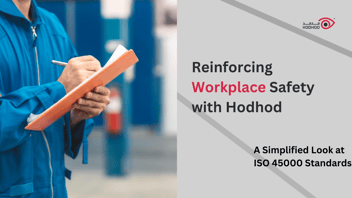"United for Safety: Embracing Collective Hazard Reporting"
"Unite for safety with collective hazard reporting and Industry 4.0 tech in modern workplaces."
"Breaking the Myth: Safety is Everyone's Responsibility" This was the title of a recent blog post that highlighted the importance of embracing Industry 4.0 technologies to transform safety management. In this blog, we'll delve deeper into the critical role hazard reporting plays in creating a safe work environment, discuss the challenges faced by employees in traditional safety management systems, and explore the various types of hazards. We will also share practical advice on how a combination of technology, cultural shift, and adherence to safety standards can make hazard reporting a collective responsibility.
Hazard reporting is a cornerstone of workplace safety and a crucial aspect of EHS software implementation. It empowers employees and stakeholders to identify potential risks, such as safety fails, fire evacuation management issues, or inadequacies in work permits, and address them before they escalate into serious incidents. However, in many organizations, hazard reporting is solely the responsibility of a designated safety team, typically led by an HSE manager. This approach, unfortunately, leads to a culture where people hesitate to voice their concerns, assuming that someone else will handle the issue.
So why is hazard reporting not as widespread as it should be? The answer lies in the barriers employees face when using traditional safety management methods. People may be reluctant to report hazards due to fear of retribution, lack of anonymity, or the belief that their concerns won't be taken seriously. This reluctance can have dangerous consequences, particularly when dealing with fire fighting systems, MSDS, or root cause analysis.
Unreported hazards can take various forms, including physical, chemical, biological, and ergonomic risks. If these hazards remain unaddressed, they can lead to accidents, injuries, and even fatalities. Moreover, unreported hazards can impact workplace morale, productivity, and the overall well-being of employees, hindering the path towards digitalization and Industry 4.0.
To overcome these challenges, we must create a culture where hazard reporting is encouraged and embraced by everyone. Integrating Industry 4.0 technologies, such as machine learning, video analytics, and data analytics, can help foster a more collaborative and transparent approach to safety management. By using technology to identify, report, and address potential hazards, we can create an environment where every stakeholder actively participates in promoting safety.
However, technology alone is not sufficient. A shift in mindset and culture is crucial to making hazard reporting a collective responsibility. Encouraging open communication, providing a secure platform for reporting, and prioritizing safety alongside productivity and profitability are essential steps towards this goal.
In addition to adopting technology, a shift in mindset and culture is crucial to making hazard reporting a collective responsibility, ultimately uniting us for safety in the modern workplace. Here are some practical tips for organizations to improve their hazard reporting process:
- Develop clear guidelines for hazard identification and reporting, and ensure that employees are trained to follow these procedures.
- Implement a user-friendly reporting system(hyperlink to hazard reporting) that allows for anonymity, fostering a sense of security among employees who may be hesitant to report hazards.
- Establish a transparent system for tracking and addressing reported hazards, ensuring that employees are aware of the progress made in addressing their concerns.
- Encourage regular communication between employees, supervisors, and safety teams to foster a culture of collaboration and trust.
- Regularly review and update hazard reporting processes and procedures to ensure their effectiveness and compliance with industry standards.
By embracing industry 4.0 technologies, fostering a culture of collaboration, transparency, and open communication, and implementing practical strategies, we can make significant strides in ensuring a safer workplace for everyone. Moreover, by integrating best practices from standards like OHSAS and ISO 45001, organizations can further enhance their hazard reporting systems, leading to more effective prevention and management of workplace hazards. In doing so, we not only protect employees but also contribute to increased productivity, morale, and overall well-being.
By understanding the various types of hazards and the potential risks they pose, employees can become more proactive in reporting concerns, ultimately contributing to a safer work environment. The combination of technology, cultural shift, and practical advice can transform hazard reporting from a designated responsibility to a collective effort, making our workplaces safer for all.
Discover how we are utilizing Industry 4.0 technologies to transform safety management at https://hodhod.io/. Embrace the future of workplace safety, and take the first step towards creating a safer and more productive work environment for everyone.
For Free Trial : https://hodhod.io/free-trial/


